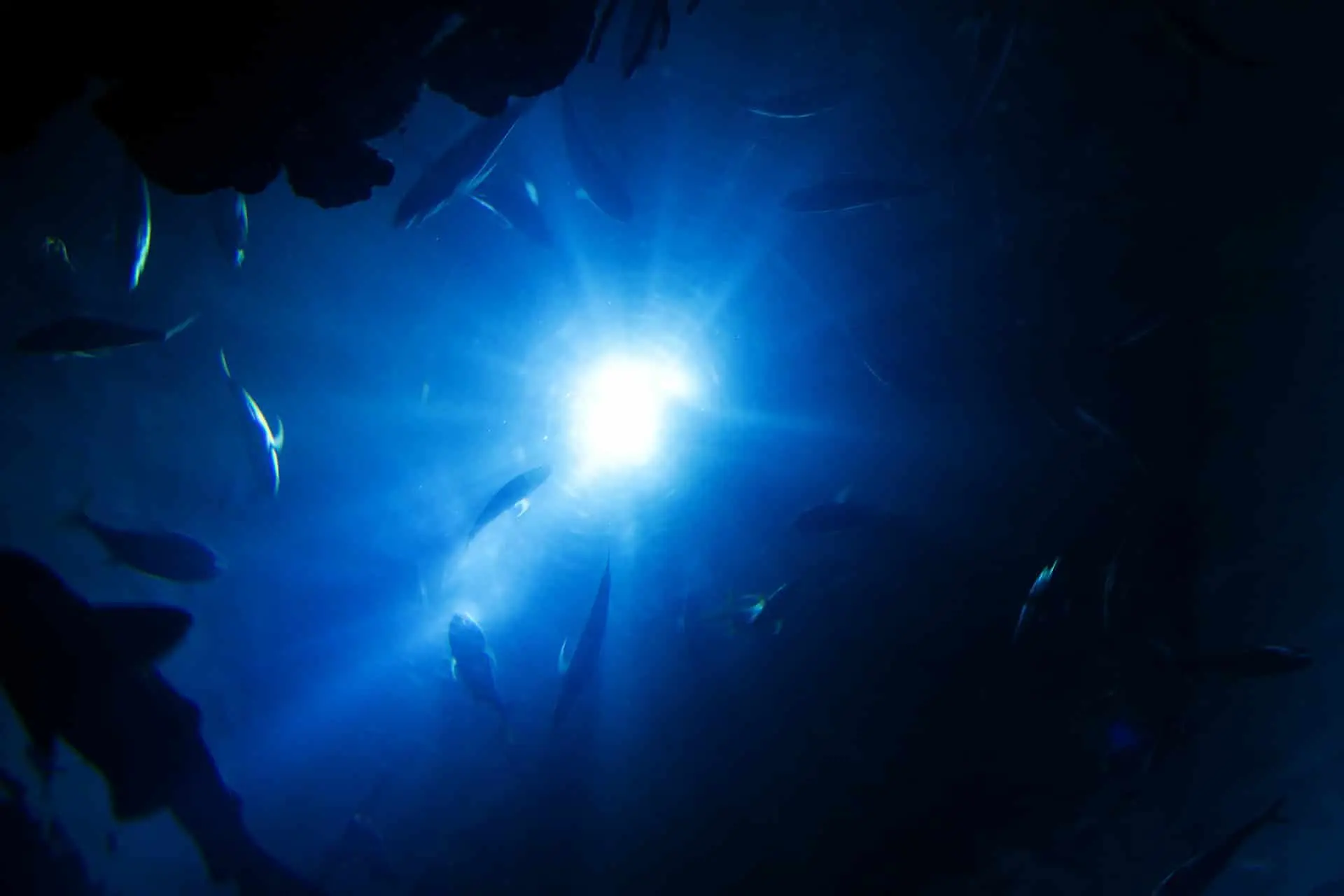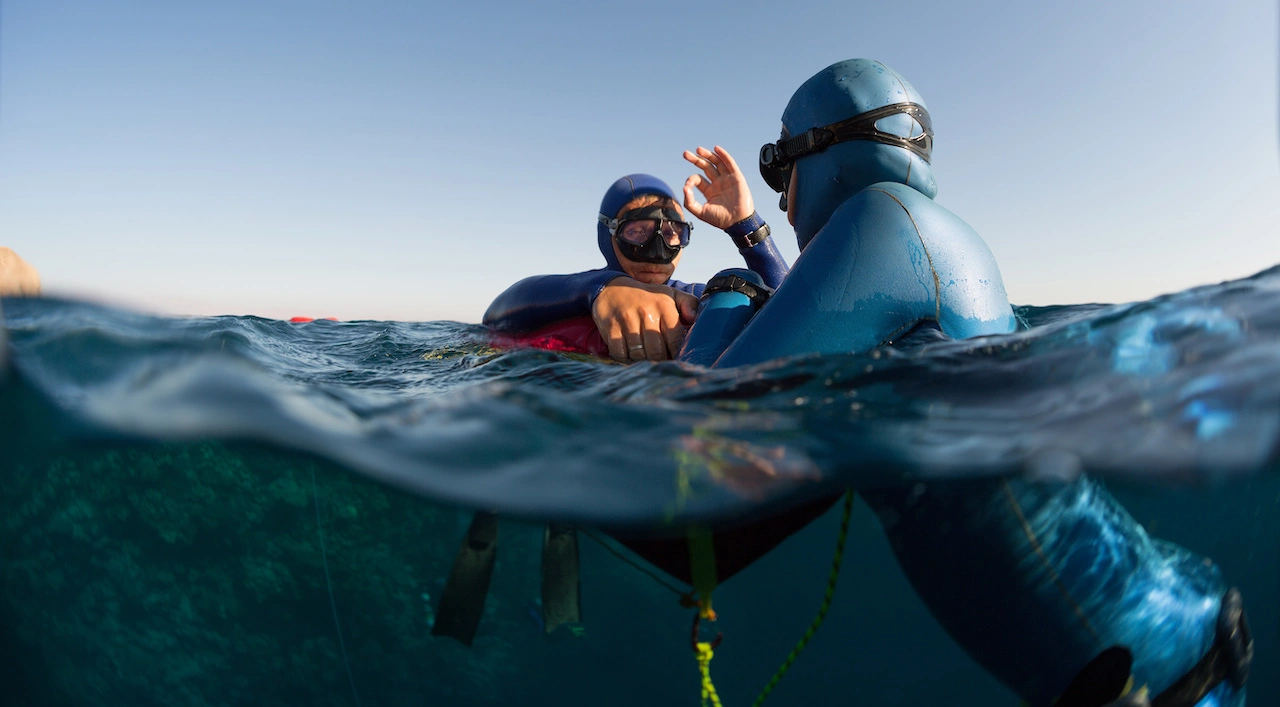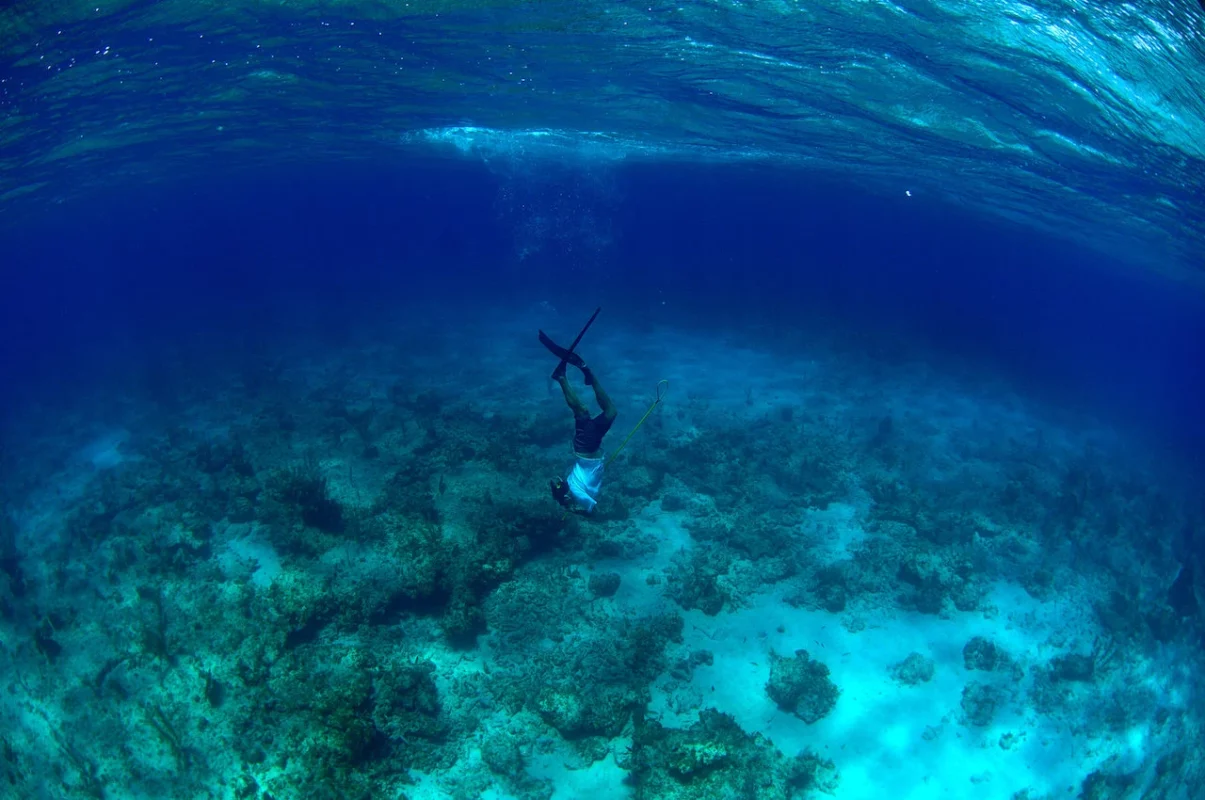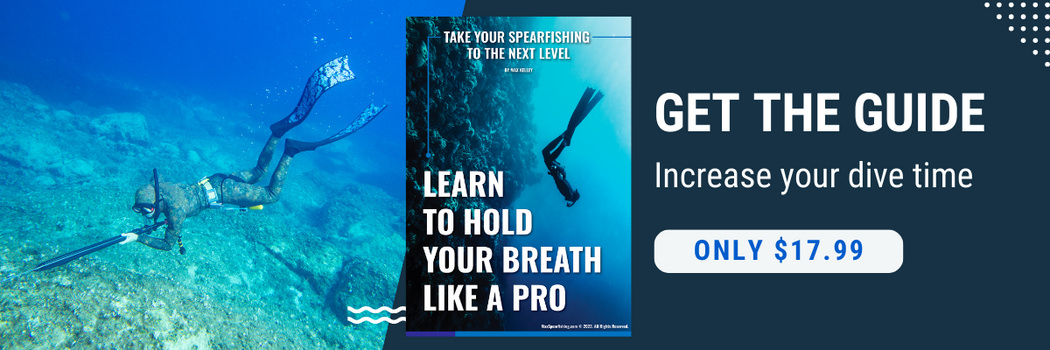No products in the cart.
Spearfishing Advice
How to Hold Your Breath Underwater for Spearfishing
If you want to become better at spearfishing, one of the most important things to work on is learning how to hold your breath underwater.
Because the longer you can hold your breath, the longer you can stay underwater. And the more time you spend on the bottom, the higher your chances of finding the perfect fish to catch. You can sit in ambush, or explore a larger hunting ground. You can dive deeper, and investigate different areas a fish might be hiding.
But before we dive into the techniques to hold your breath underwater, it’s critical you’re doing it safely.
Max Spearfishing is reader-supported. We may earn a small commission for purchases using our links. Click here to learn more.
How to Hold Your Breath Underwater for Spearfishing
Increasing the amount of time you can hold your breath underwater will help you get better at spearfishing. So long as you do it safely. The techniques you’ll learn in this article are advanced, and should never be practiced alone. We cover the importance of having a dive buddy in many articles, because it’s no joke. Pushing your breath hold limits will eventually result in pushing yourself a little too far. If you’re alone, and you experience a shallow water blackout, you’re done for. It’s a recipe for disaster.
Stay safe when you’re increasing your breath holds
When I was just getting started I used to spearfish on my own all the time. But after a close friend lost his life on a shallow dive, I realized how dangerous this sport really is. He blacked out after trying to pull a crayfish out of a cave in just 18 feet of water. He’d been spearfishing solo for years, and he called himself a lone wolf. The trouble, was that as he pushed his breath hold to the limit, there was no dive-buddy nearby to get him back to the surface when he blacked out.
These days, it’s very, very rare that I’ll do a solo dive. In fact, it’s probably over a year since I’ve risked it alone. You need a dive buddy who you can rely on to be there if the situation ever demands it. Someone who knows what to watch for. Who can pull you from the water and get you breathing again if you black out. It’s also important to pay attention to your body. If you ever start feeling lightheaded, dizzy, a tingling in your skin or anything that’s just not right when you’re in the water, get to the surface as fast as possible.
The two key rules as you hold your breath underwater
For anyone looking to increase the time they spend underwater spearfishing, there are two key rules to follow.
- Don’t burn any of your oxygen unnecessarily.
- Make the best use of your time underwater.
Because you’re only able to hold your breath underwater for so long. Which means that you need to make the most efficient use of your time with the oxygen you have in your lungs. It will run out, and it will run out fast. So pay attention to the tips that follow and learn how you can maximize your time underwater.
Use deep breathing exercises to warm up
I like to do a few warm-up stretches to loosen up before I even get in the water, along with a series of deep breathing exercises. It helps me to stay calm and centered, while also stretching and expanding my lungs right before we start a spearfishing session. Here’s how I do it:
- Place your right hand on your chest, and your left on the top of your stomach
- Inhale for 5 to 7 seconds, imagining the air is filling your stomach first
- You should notice your left hand is moving while your right is not
- Once your lower lungs are full, shift and start filling the top part of your lungs
- You should notice your right hand has started moving and your left is stable
- When you’re almost done, look straight up and gasp in one more mouthful of air
- Hold this for 10 seconds, before you start a controlled exhale for 15 seconds
- You want to release the air from the top of your lungs first
- Once this is clear, push your abdominal muscles and release the rest of the air
- Repeat 5 times.
Equalize before you hold your breath underwater
Now not many people know this, but it’s a neat trick I picked up on a recent freediving course. What you want to do, is force your ears to equalize before you even start trying to hold your breath underwater. It’s something that not a lot of people do, but it helps you make a clean duck-dive and a fast descent.
What you’re doing with this trick is known as a “pre-equalization.” Because you’re still on the surface. Before breaking down to start spearfishing underwater, hold your nose and force yourself to equalize first. It’s a neat little trick that means you don’t have to start worrying about equalizing again till you’re a good 5 to 7 feet deeper. Instead, you can concentrate solely on making a clean duck-dive. When I do this, I’m much calmer as I begin my descent, and I find that I can generally get a longer breath hold time out of it.
Hold your breath for longer by staying calm
We mentioned earlier not to burn your oxygen unnecessarily, which makes it critical to stay calm underwater. When you’re tense or pushing yourself too strenuously, your heart rate escalates. A higher heart rate burns your stored oxygen much faster. And as a result, cuts the amount of time you can hold your breath underwater considerably.
Once I’m kicking around on the surface of the water, I try to follow a regular pattern with my breaths. My focus is on keeping my muscles as loose and relaxed as possible. I’ve usually only got a light grip on my gun, and I tend to let the boat and the currents pull me where I need to dive. Instead of fighting the ocean I roll with it. This is a far more oxygen efficient form of spearfishing, that keeps my heart rate low and maximizes my time underwater.
Of course, this sometimes requires that I’m dropped off up-current from where I want to spearfish, but that’s not an issue. It’s just a matter of planning each dive accordingly.

Don’t try to do too much while underwater
On a similar note, you don’t want to push yourself too hard while you’re holding your breath. Swimming a great distance underwater may seem like the best way to explore and hunt your fish. But it’s the wrong strategy. Though in some cases this will be the type of spearfishing you need to do, for the most part I try to avoid it. Swimming underwater burns your oxygen, and even if you’re doing it in a calm and controlled manner it’s likely you’ll scare the fish away.
The spearfishing technique I have the most success with is the ambush. Finding a place to settle down and wait. For this to work, you will need a good spearfishing spot where there’s plenty of fish activity. But by staying still you’ll conserve your oxygen. That’ll help you hold your breath underwater for longer, and give any interested fish to come investigate the camouflage-laden human laying on the sea floor.
Save oxygen with calm and controlled movements
Again, if you’re causing a huge ruckus underwater you’re going to scare the fish away. There’s no point pushing yourself to stay underwater so long that you’ve got to make a frantic dash for the surface at the end of your dive. I’ve had much more success by staying calm and in control, and leaving a fish on the bottom when my dive is timing out. That way I can resurface, prep again for another dive, and start spearfishing on a fresh breath. That way, I can simply make the shot on my second dive.
I also find that once I’m on the bottom I rarely use my fins to propel me around. Instead, I grip a rock with my hand, and use my arms to pull me around. This technique burns less oxygen than kicking, and is also less likely to spook any fish hanging about.
Position your body as flat as possible
The best position I’ve found when spearfishing is to lie flat on the bottom, with my thighs and stomach against the sea bed. It’s an ambush position, where you can still extend your speargun out. Or even push off with your hands and knees in case you need to make a quick move to follow a target fish.
What I like about lying flat on the bottom, is it cuts your profile down. So that you’re less affected by the swell and any current, and makes you look like less of a threat to any fish in the area. If you look like less of a treat, any nearby fish are much more likely to come closer. I also find that when I’m laying flat I’m more relaxed. Because I’m not trying to balance on my knees while fighting off the movement in the water, which means I’m able to hold my breath underwater for longer.
Get your spearfishing weight belt right
One of the biggest problems I had when I first started spearfishing was using an incorrect amount of weight. Not really knowing what I was doing, I’d actually put far too little lead on my weight belt. The result? I was always fighting my buoyancy. Fighting to push myself to the bottom. Struggling to stay down there. And having to deal with the swell of the waves that was always trying to push me out of my ambush spearfishing position.
All of this effort meant my average bottom time was around 15 to 20 seconds. Instead, you’ve got to get your weights right, so you’re able to lie calmly on the ocean bottom. Remember, staying calm is key. That’s how to hold your breath underwater the right way.
Stay safe as you hold your breath underwater
As you start learning how to hold your breath underwater for longer, it’ll get easier and easier to extend your dive times. You’ll start pushing your dives out to a minute, then a minute and a half, or even two, depending on your fitness levels and overall diving abilities. But just because you can push yourself to have a long bottom time, it doesn’t always mean you should hold your breath underwater for this long. Remember how I mentioned safety?
The longer you hold your breath underwater, the higher the chances you’ll experience a black out. Or as we call it in spearfishing, a shallow water blackout. It’s how your body reacts to a lack of oxygen. Shutting down as your oxygen stores get low, in order to keep you alive as long as possible. The danger, is that this happens underwater.
For me, the first time I blacked out underwater I was lucky. I pushed myself a little too hard after losing a crayfish from my grip. Opting to chase it to the bottom at the end of my dive, instead of leaving it to recover on the surface. All I remember is things fading out, and feeling weightless in the water. My buddy saw me spasming and was the one to pull me back to the surface. If I was spearfishing alone, I wouldn’t have made it home that day.

Use smart technology for longer breath holds
It’s important too, that you’re leveraging technology. I track all of my dives with a freediving watch. For the longest time I used the Oceanic F10 V3 Freedive Watch, however a couple of years ago upgraded to a Garmin Descent and never looked back. I wear the Mk2i now, and it tracks everything.
Telling me exactly how long I can dive in specific circumstances, with a haptic feedback alarm once a limit is met. It starts vibrating and I know it’s time to move. Plus the battery life is amazing, and you can store data from over 200 dives, right there on your wrist. It’s the perfect upgrade if you’re looking to increase your ability to hold your breath underwater. Allowing you to track, analyze and improve, all based on your own personal data.
No products found.
Optimize your dives for maximum bottom time
What I love about these optimizations you can make, is how much more overall bottom time you get. Because there’s also a smart reason to not push yourself too hard.
Spend too long underwater and you’ll need to spend longer on the surface recovering. Which when you add it all up at the end of the day, means you spend far less time spearfishing in the actual “kill zone.” My spearfishing dives now, typically look like this.
I usually dive a 1:30 surface to surface. In 20 – 30 feet of water, I then need to spend about 2 minutes resting and preparing for the next dive on the surface. Over the course of an hour, (assuming I take 15 seconds to dive and surface) that’s about 17 minutes of bottom time, with 34 minutes of rest on the surface, and 17 dives per hour.
Now let’s imagine a different scenario. I push myself to stay on the bottom for 2 minutes.
In 20 – 30 feet of water, I run a 2:30 surface to surface dive. This is almost my limit for holding my breath underwater, and I’m buggered when I resurface. It takes me about 5 minutes to recover enough to even attempt the next dive. Over the course of an hour (assuming again I take 15 seconds to dive and surface), that’s only 16 minutes of bottom time. Assuming I am able to continue pushing these long bottom times of course, this means I only get 8 dives per hour.
Do you see the difference? Shorter, more frequent dives are not only safer, they cut your recovery time down. And allow you to spend more time underwater spearfishing. Trying to hold your breath underwater for as long as possible, isn’t always ideal. With far fewer dives per hour, you’re also exploring fewer spots. Which may mean you miss out on a potentially great spearfishing spot because you’ve stayed in one place for far too long.
On my home reef this technique wouldn’t work, as you’ve got to actually dive to find the fish first.
Master these techniques to hold your breath underwater
The real key to spearfishing is practice. Practicing techniques like these, that enable you to hold your breath underwater allows you to become the most effective hunter possible. Just remember, that staying deeper for longer doesn’t necessarily make you a better hunter. You also need a keen awareness of what’s going on around you, and to make the most of every dive you make.
A long dive may be necessary if you’re hiding out in a compression point awaiting some big game fish, but generally I bring home far more fish when I’m simply following my watch. Regular, shorter dives are safer, and give you a longer bottom time. And the more good dives you get in, the better your chances of a good catch.
Happy spearin’


